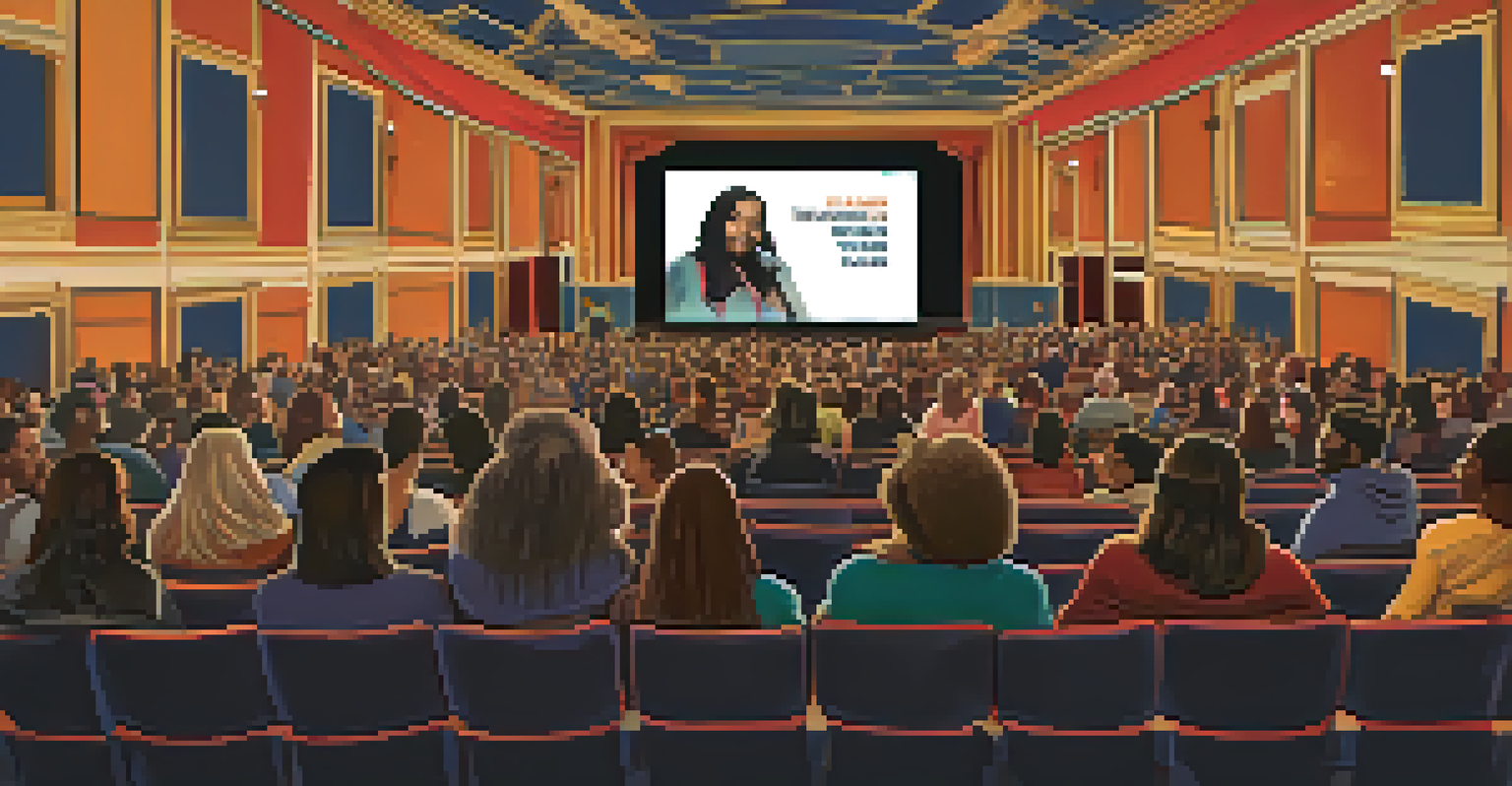The Impact of COVID-19 on Film Theater Operations

Initial Closure of Theaters: A Dramatic Shift
When COVID-19 began spreading globally in early 2020, theaters were among the first public venues to close their doors. This sudden shutdown left millions of moviegoers craving their cinematic experiences while companies scrambled to adapt to the new reality. For many theaters, especially independent ones, this closure was devastating, leading to financial strain and uncertainty about their future.
The cinema is a matter of life and death for us, but it is not a matter of life and death for the audience.
As the pandemic continued, many theaters faced extended periods of inactivity, which forced them to rethink their operational models. With ticket sales plummeting, they had to explore alternative revenue streams and find ways to engage with audiences from a distance. This situation pushed theaters to utilize digital platforms, leading to innovative solutions such as virtual screenings and drive-in experiences.
The rapid shift to online platforms meant that theaters had to compete with streaming giants that were thriving during the pandemic. This prompted discussions among industry professionals about the future of film distribution and the role that traditional theaters would play. Ultimately, the initial closure of theaters marked a turning point that would reshape their operations for years to come.
Health Protocols and Safety Measures Implemented
As theaters started to reopen, health protocols became a top priority to ensure the safety of audiences and staff. This included measures such as social distancing seating arrangements, mandatory mask-wearing, and enhanced sanitation practices between screenings. The goal was to create a safe environment that would encourage moviegoers to return without fear.

The implementation of these protocols required significant investment and training for theater employees. Many venues had to adapt their operations, from reconfiguring seating to implementing contactless ticketing and concession sales. These changes were not just temporary fixes but rather a new standard for how theaters would operate moving forward.
Theater Closures Spark Innovation
The initial shutdown of theaters due to COVID-19 led to creative adaptations, including virtual screenings and drive-in experiences.
As audiences adjusted to these new safety measures, some even reported feeling more comfortable in a theater environment compared to other public spaces. This surprising outcome highlighted a potential pathway for theaters to regain public trust and gradually rebuild their audience base, all while prioritizing health and safety.
Shifts in Audience Behavior and Preferences
The pandemic fundamentally altered audience behavior and preferences, with many people reassessing their movie-watching habits. With more time spent at home, audiences became accustomed to streaming films, leading to a rise in the demand for at-home entertainment. This shift forced theaters to consider what unique experiences they could offer that viewers couldn't replicate at home.
The future is not something we enter. The future is something we create.
As theaters began reopening, they noticed a change in the types of films that audiences were eager to see. Blockbusters and franchise films still drew crowds, but there was also a notable interest in indie films and documentaries that resonated with the current climate. This shift indicated a desire for diverse storytelling, pushing theaters to curate more varied programming.
Moreover, audience demographics changed during the pandemic, with younger viewers often leading the charge back to theaters. This demographic shift encouraged theaters to embrace more technology, including mobile apps for ticket purchases and loyalty programs, making the theater experience more appealing to the tech-savvy generation.
Rise of Streaming Services and Their Influence
The pandemic accelerated the already growing popularity of streaming services, which became essential for many viewers during lockdowns. As theaters faced closures, major studios began releasing films directly to streaming platforms, altering the traditional distribution model. This shift raised questions about the future of theatrical releases and how theaters could remain relevant in a streaming-dominated landscape.
With consumers now having immediate access to the latest films at home, theaters had to rethink their business strategies. Some theaters began to partner with streaming services to offer exclusive screenings or events, creating a hybrid model that could benefit both parties. This collaboration marked a new era, where theaters could still play a vital role in film distribution.
Health Protocols Reshape Operations
The implementation of health and safety measures became essential for theaters to regain audience trust and ensure safe moviegoing experiences.
As a result, studios and theaters are now navigating a complex relationship, balancing the need for box office revenue with the convenience of streaming. The challenge lies in finding ways to entice audiences back into theaters while still accommodating the changes in viewing habits that the pandemic has brought about.
Financial Struggles and Support for Theaters
The financial impact of the pandemic on theaters was severe, with many facing the risk of permanent closure. While larger chains had some resilience, independent theaters, which often operate on thin margins, were particularly hard hit. As revenue dwindled, many theaters turned to crowdfunding and community support to survive the crisis.
In response to the challenges faced by the industry, various government initiatives and grants were introduced to provide relief for struggling theaters. These programs aimed to support local businesses and preserve the cultural significance of independent cinemas. Such efforts highlighted the importance of theaters as community hubs and cultural institutions.
Despite these challenges, many theaters have shown remarkable resilience. By adapting their business models and engaging with their local communities, many have managed to weather the financial storm. This adaptability is a testament to the dedication of theater owners and staff who are committed to keeping the cinematic experience alive.
Innovation in Film Viewing Experiences
COVID-19 sparked a wave of innovation within the film industry, leading to new viewing experiences that catered to evolving audience needs. The rise of outdoor screenings, drive-in theaters, and private screenings for small groups provided unique alternatives to traditional moviegoing. These options allowed audiences to enjoy films in a safe and socially distanced manner, reigniting their love for the cinema.
Additionally, theaters began to enhance their in-house experiences by incorporating technology. Many venues now offer improved sound systems, better seating options, and even gourmet dining experiences during screenings. This shift towards creating a more immersive environment sets theaters apart from the convenience of home viewing.
Streaming Services Change Landscape
The rise of streaming services during the pandemic forced theaters to rethink their business strategies and explore hybrid models of film distribution.
The push for innovation didn't stop at physical changes; theaters also explored creative programming, such as themed events and Q&A sessions with filmmakers. These unique experiences not only attracted audiences back but also fostered a sense of community among film lovers. As theaters continue to innovate, they are redefining what it means to enjoy a film on the big screen.
The Future of Film Theaters Post-Pandemic
Looking ahead, the future of film theaters seems to be a blend of traditional and modern practices. The lessons learned during the pandemic have prompted theaters to adopt more flexible models, allowing them to cater to both in-person and virtual audiences. This hybrid approach could become a lasting trend, bridging the gap between cinema and home viewing experiences.
Moreover, as audiences return, theaters are likely to focus on curating unique and diverse content that resonates with their communities. By fostering relationships with local filmmakers and artists, theaters can become key players in promoting independent cinema and storytelling. This strategy could help theaters carve out a niche in an increasingly competitive landscape.

Ultimately, the future of film theaters will depend on their ability to adapt and innovate in a rapidly changing environment. By embracing new technologies, fostering community engagement, and prioritizing audience needs, theaters can not only survive but thrive in the post-pandemic world.